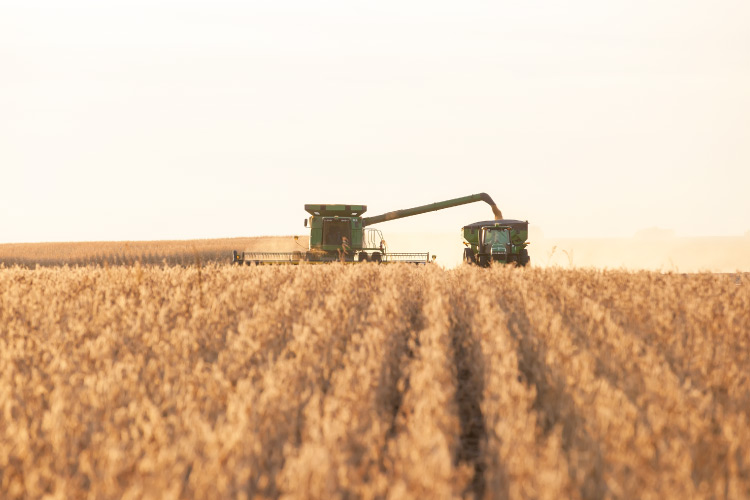Grower’s First Xtend Soybean Fields Look A+

By: John Dietz
Nadeau is one of the senior soybean growers in Manitoba. Nadeau Seeds Inc, at Fannystelle, is on the western edge of the Red River clay-loam soils. The family has operated a cleaning facility since 1967. This year, Brian put in his 13th crop of soybeans.
“NorthStar Genetics supplied the Xtend seed for two fields,” he says.
One is NSC Starbuck RR2X. It is rated for 2425 CHU as a mid- to long-season variety suited to the eastern Prairies.
The other is NSC EXP 114 RR2X. It is the earliest Xtend variety from NorthStar, rated at 2275 CHU. It is due to be named soon.
Both lines have the new Roundup Ready 2 Xtend technology, resistance to both glyphosate and dicamba. They are ready to enter the market this fall. Xtend technology is licensed in Canada, the United States, and recently, in the European Union.
Along with the two-trait seed, Monsanto is introducing a new herbicide — XtendiMax with VaporGrip Technology herbicide. XtendiMax contains a proprietary formulation of dicamba that controls broadleaf weeds in the Roundup Ready 2 Xtend system in soybeans.
As a system, this sets the stage for managing resistance to glyphosate while enhancing control of weeds such as kochia, wild buckwheat, and Canada thistle.
“The key thing for Xtend is weed control. We don’t want weeds building up with Roundup resistance,” Nadeau says.
Spring 2016
Nadeau waited to plant his NorthStar Xtend seed until all his other soybean seed was planted.
“The condition of the fields was very good. This seed is a bit more expensive, and the supply was limited, so we kept it for last to avoid any risk of frost damage,” he says.
The planting date for both fields was May 17. Since then, the farm has had about nine inches of rain. The new soybeans were at about the R2 stage in mid-July, starting to flower and showing some initial pods. Nadeau hopes to harvest in mid-September.
Nadeau was extremely cautious with weed control. He applied the pre-emerge XtendiMax at 0.7 litres per acre in 13 gallons of water, with 25 psi and travelling at 8 mph. Wind was about 8 km/h at the start.
“When the wind came up a little, to about 14 km/h, we quit. Where it would be normal to still be spraying, we quit. Those fields stayed whistle-clean for 20 days, for sure. We almost couldn’t find a weed; it was so impressive.
“We did our second application at 0.3 litres per acre. The crop came through, stayed extremely clean – then we got wet. It started to rain and rain. The Xtend is not made to control grasses, but it did a really good job on the buckwheat, lady’s-thumb, lambsquarter – they were done!”

Observations
The seed grower used low-drift, heavy water volume nozzles for spraying the XtendiMax. He also took extra precautions with spraying.
“Drift is the Number One issue for commercial growers,” Nadeau says. “Be extremely cautious and know your surroundings, like which field is beside you, wind direction, wind gusts. Be careful. The Xtend will take out any Roundup Ready 2 soybeans beside you. Everything around you, you can damage it.”
The big gain is weed control along with resistance management.
“The benefit is that we’re taking out a lot of weeds that WeatherMax wasn’t really handling,” Nadeau says.
“Buckwheat is the number one broadleaf weed on our farm, and it’s not even an issue this year on these two fields. When buckwheat comes to maturity in the crop, it becomes a corker to harvest,” he says.
North and west of the Red River Valley, a lot of areas are fighting kochia. That’s another issue.
“If you’re going to be fighting kochia, you want the Xtend system,” he says.
NSC EXP 114 RR2Y
At mid-July, between the two Xtend soybean fields, Nadeau is most excited about the early, short-season experimental line that’s yet to be named.
“In my EXP 114, the control is fantastic,” he says. “There’s no weeds or volunteers in it. The appearance is really good. Lush. Green. Tall. There’s excess moisture, and it’s taken that very good. The rows closed nicely. I don’t know where the yield is going, because it’s very, very early maturing, but we’re excited about it.”
NSC Starbuck RR2Y
Volunteer Roundup Ready canola from 2014 became an issue in the new Starbuck variety. Nadeau planted his Starbuck seed on winter wheat stubble.
For a few weeks, Nadeau and his agronomist saw excellent control of the volunteer canola. They had an option to add something to the post-emerge XtendiMax application to control canola in the soybeans, but decided the Starbuck field would be fine without it.
“The volunteer Roundup Ready canola out there was curling. It looked like it was dying. Then, after the second application, when it was too late to do anything, the canola grew out of it. Xtend set it back about three weeks for us, but it did not control it,” Nadeau says. “If we had known the canola would recover, we would have put something on there to control it in the soybeans.”
It’s become a second issue, but has nothing to do with NSC Starbuck.
“Volunteer canola in soybeans isn’t pretty, but it will not hurt the yield. It fooled us, and that’s something a grower should be aware of,” he says.
Onward to harvest.


